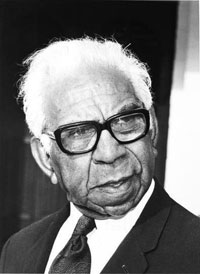
Sir Douglas Ralph Nicholls was a prominent Aboriginal Australian from the Yorta Yorta people. He was a professional athlete, Churches of Christ pastor and church planter, ceremonial officer and a pioneering campaigner for reconciliation.
Aboriginal Protection Board, also known as Aborigines Protection Board, Board for the Protection of Aborigines, Aborigines Welfare Board, and similar names, refers to a number of historical Australian state-run institutions with the function of regulating the lives of Aboriginal Australians. They were also responsible for administering the various half-caste acts where these existed and had a key role in the Stolen Generations. The boards had nearly ultimate control over Aboriginal people's lives.
John Thomas Patten was an Aboriginal Australian civil rights activist and journalist.

The Yorta Yorta, also known as Jotijota, are an Aboriginal Australian people who have traditionally inhabited the area surrounding the junction of the Goulburn and Murray Rivers in present-day north-eastern Victoria and southern New South Wales.

William Cooper was an Aboriginal Australian political activist and community leader; the first to lead a national movement recognised by the Australian Government.
Thomas Shadrach James, born Thomas Shadrach Peersahib, was a Methodist lay preacher, linguist and herbalist. However, it was as a teacher, first at Maloga Aboriginal Mission and later at Cummeragunja Reserve, that he is remembered in history. Through this role, he equipped and influenced generations of Aboriginal Australian activists, including Margaret Tucker, Pastor Doug Nicholls, George Patten, Jack Patten, William Cooper and Bill Onus.
Shadrach Livingstone James was a teacher, unionist and Aboriginal Australian activist.
William Townsend Onus Jnr was an Aboriginal Australian political activist, designer, and showman, also known for his boomerang-throwing skills. He was father of artist Lin Onus.
The Cummeragunja walk-off in 1939 was a protest by Aboriginal Australians at the Cummeragunja Station, an Aboriginal reserve in southern New South Wales.
Margaret Lilardia Tucker MBE was an Aboriginal Australian activist and writer who was among the first Aboriginal authors to publish an autobiography, in 1977.

The Australian Aborigines' League was established in Melbourne, Australia, in 1933 by William Cooper and others, including Margaret Tucker, Eric Onus, Anna and Caleb Morgan, and Shadrach James. Cooper was secretary of the League.
An Aboriginal reserve, also called simply reserve, was a government-sanctioned settlement for Aboriginal Australians, created under various state and federal legislation. Along with missions and other institutions, they were used from the 19th century to the 1960s to keep Aboriginal people separate from the white Australian population, for various reasons perceived by the government of the day. The Aboriginal reserve laws gave governments much power over all aspects of Aboriginal people’s lives.
The NSW Aboriginal Land Council (NSWALC) is the peak representative body of Aboriginal Australians in New South Wales. It has the mandate, under the Aboriginal Land Rights Act 1983 (NSW), to develop land rights among Aboriginal people in New South Wales through its network of 120 Local Aboriginal Land Councils (LALCs). Its functions include the creation of an economic base for Aboriginal communities, as well as the continued passing and enhancement of Aboriginal culture, identity and heritage through the management of traditional sites and other cultural materials within NSW. It acts as an advisor to governments and others to ensure the preservation of Aboriginal land rights.

Maloga Aboriginal Mission Station also known as Maloga Mission or Mologa Mission was established about 15 miles (24 km) from the township of Moama, on the banks of the Murray River in New South Wales, Australia. It was on the edge of an extensive forest reserve. Maloga Mission was a private venture established by Daniel Matthews, a Christian missionary and school teacher, and his brother William. The mission station operated intermittently in 1874, becoming permanent in 1876. The Mission closed in 1888, after dissatisfied residents moved about 5 miles (8 km) upriver to Cummeragunja Reserve, with all of the buildings being re-built there.
Purfleet is a small suburb of the Greater Taree region, located within the Mid-Coast Council local government area of New South Wales, Australia. It is situated approximately 313 kilometres (194 mi) north of Sydney.
The New South Wales Aborigines Protection Association, also known as NSW Aborigines Protection Association, Association for the Protection of Aborigines, Aborigines Protection Association and Aboriginal Protection Association, was a private body which supported Aboriginal Australians in New South Wales, Australia. Specifically, it administered Maloga Mission until the residents moved to Cumeroogunga, and the mission stations at Warangesda and Brewarrina.

Ellen Campbell Atkinson was an Australian Aboriginal community leader. Born in Madowla Park, near Echuca in Victoria, Atkinson and her family were forced to move frequently, either through the necessity of finding work, or forcibly by authorities. She converted to Christianity when the Aborigines' Inland Mission (AIM) visited the Cummeragunja Reserve, where she was living, and served the mission for many years in roles such as organist and deacon.
Elizabeth Maud Hoffman, née Morgan, also known as Aunty Liz or Yarmauk, was an Australian Indigenous rights activist and public servant. She co-founded the first Indigenous Woman's Refuge in Australia, named "The Elizabeth Hoffman House" in her honour. She was one of 250 women included in the Victorian Honour Roll of Women in 2001 and received the inaugural NAIDOC Lifetime Achievement Award in 2006.





